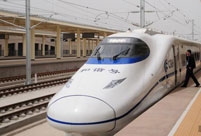 Luoyang aims to become 'Chinese Culture City'
Luoyang aims to become 'Chinese Culture City'
 Century-old jade disc found confirms ancient legend
Century-old jade disc found confirms ancient legend
 A serious mind behind Chinese leader
A serious mind behind Chinese leader
 Panda Cubs to Predict 2014 World Cup Winners
Panda Cubs to Predict 2014 World Cup Winners
 China Southern Airlines flight attendants win titles in service contest
China Southern Airlines flight attendants win titles in service contest
 Pupil's performance art persuades people to stop smoking
Pupil's performance art persuades people to stop smoking
 Nie Chenxi's clay tigers
Nie Chenxi's clay tigers
 Children's Day wishes
Children's Day wishes
 Chinese Kung Fu charms Silicon Valley
Chinese Kung Fu charms Silicon Valley
 Tranquil Yankou ancient town
Tranquil Yankou ancient town
Feature of Qi Zhala, standing committee member of CPC Tibet Autonomous Region and municipal party secretary of Lhasa
The 2013 Public Service Blueprint published by the Chinese Academy of Social Sciences shows that the rating of basic public service in Lhasa ranks on top of 38 major Chinese cities, with ratings of the public transport, public security, social security and employment, urban environment, culture and sports, and the GDP leverage indicator all ranking on top of the list. Among the indicators, the satisfaction leverage indicator of GDP towards public services ranks the highest among all 38 cities, while the public security index has remained the highest three years in a row, and the public transport, social security and employment, and urban environment indicators rank the 1st two years in a row.
Despite such excellent performance, Qi Zhala, standing committee member of CPC Tibet Autonomous Region and municipal party secretary of Lhasa, believes that Lhasa could do it better. Through the five strategies of establishing the city environmentally, prospering the city culturally, enhancing the city industrially, maintaining the city with livelihood, and stabilizing the city with rule of law, Lhasa will achieve the leapfrog and sustainable development in order to inscribe the gorgeous Lhasa poem of the Chinese dream.
Bear the words of General Secretary in mind to instill the Lhasa vitality into the Chinese dream
J: You’ve proposed to utilize the entire force of Lhasa to inscribe the Lhasa poem of the Chinese dream. Why is that, what makes you so determined to do so?
Qi Zhala: First of all, itat makes you so determined to do so? to inscribe the Lhasa Jinping said. On March 9, 2013, the general secretary Xi Jinping shared with us his profound interpretation of the strategic position of Tibet in the deliberation process with the representatives from Tibet of the first session of the 12th National Peoplession of the 12he 12e representatives from Tibet of“Tibet is the important national and ecological security defense,” and that “the foremost strategy to govern the country starts with the border, whereas the border matters about stabilizing Tibet in the first place.” It is hence of utmost importance to guarantee stability in Tibet in safeguarding the border, and to regard the stable development of the Tibetan regions as the core national interest. The General Secretary has definitely put the stability and development of Tibet into the blueprint of the Chinese dream of the great rejuvenation of the Chinese nation.
Secondly, as the capital city of the Tibet Autonomous Region, Lhasa is the forefront region that safeguards the southwestern part of China and connects south Asia. During the long realization of “the Chinese dream”, people from various ethnicities of Lhasa will be jointly guided by the spirits of the third plenary session of the 18th Peopley guided by the spirits of the third plenary session of the 18na and connects south Asia. During the long realization of n of long realization of national interest. The General SecrChinese dream more brighter and gorgeous.
J: After becoming the municipal party secretary of Lhasa, you have raised the five strategies of establishing the city environmentally, prospering the city culturally, enhancing the city industrially, maintaining the city with livelihood, and stabilizing the city with rule of law, all of which have now become the consensus of the party and the political circle of Lhasa. I have also born witness to that during my interview process. So under what context did you bring up the five strategies?
Qi Zhala: The five strategies of establishing the city environmentally, prospering the city culturally, enhancing the city industrially, maintaining the city with livelihood, and stabilizing the city with rule of law are first of all what Lhasa needs for its development. It is with great timing, favorable geography and good human harmony that the five strategies came out at this time.
J: How do you explain great timing, favorable geography and good human harmony?
Qi Zhala: Each strategy cannot be independent from its time and era. For an ancient city like Lhasa, with its sensitive politics and huge international influence, any reform will not be available to push forward if the comprehensive timing is not mature yet.
The reasons for the five strategies to be brought up are that, first of all, Lhasa has been cared about by the central government. From Mao Zedong to Deng Xiaoping, Jiang Zemin and Hu Jintao, each generation of leaders invariably has been very caring about Lhasa. In 2011, Xi Jinping gave a speech during the celebrating ceremony on the 60th anniversary of the establishment of the Tibet Autonomous Region in representative of the central government, which caused a stir in Tibet. The unchanging love of the central party for Tibet, plus the continued implementation of the Great Development in the West makes up the timing for Tibet.
In 2011, the regional party secretary of the autonomous region, Chen Quanguo, came up with the idea that Lhasa needed to play its potential as the capital city and brought up the requirements on Lhasa’s development. This marked the kick-start of the development of Lhasa. Besides, Beijing and Jiangsu Province have also provided unselfish support for Tibet, all these make up the geological timing of Tibet.
The good human harmony means political and public support. After the reform and opening up, Lhasa has reached the consensus between reform and development. It is now qualified with the basics of development. People of all ethnicities in Lhasa are also taking stability as a top priority, because they yearn strongly for development.
J: What is the relationship between the five strategies and the Chinese dream?
Qi Zhala: The five strategies are the basis and grip for Lhasa to put the Chinese dream into practice.
Establishing the city environmentally to build the ecologically friendly plateau city
J: Why do you put the environment as the first strategy of the five strategies?
Qi Zhala: Environmental construction is not only the policy need of the party, but also the prerequisite and basic preconditions for the leapfrog development and long term peace and order of Lhasa.
The 18th party congress proposed the five dimensional constructions of the economy, the politics, the culture, the society and the ecological civilization in order to establish the well-off society in an all-round way, to realize the socialist modernization and the great rejuvenation of the Chinese nation. The third plenary session of the 18th congress clearly defined the systematic reform in building the beautiful China and intensifying the ecological civilization. It also proposed to speed up the establishment of the ecological civilization system, complete the mechanism of national land development, resource conservation, and ecological environment protection, in order to establish the new construction pattern of the modernization that harmoniously integrates human and nature together. The central urbanization working conference also pointed out to inherit culture and develop beautiful cities and towns that boast historical memories, regional features, as well as ethnic characteristics. The central party and the State Council have listed ecological civilization construction on top of the agenda of the Chinese dream of great rejuvenation of the Chinese nation, which provided the direction of environmental development for Lhasa to inscribe the new poem of the Chinese dream.
In order to establish the city environmentally, we need to put our efforts in establishing superior ecological environment, living environment, and investment environment.
In order to make the strategies practicable and popular, the Municipal Party Committee and the Municipal Government have proposed the three specific and iconic projects of “mountain planting,” “turning rivers into lakes,” and “bringing central heating into the households.” by correlating the practice to the peculiarity of Lhasa.
J: What is “mountain planting”? What have you done in terms of that?
Qi Zhala: The so-called “mountain planting” is to carry out the greening projects on arid mountains so as to make Lhasa a green and ecological city.
Specifically, we have invited experts with experience in tree planting in arid areas in Israel and the US to provide us guidance in making the arid and bald mountains in Lhasa green. We will also continue to carry out the greening projects on arterial roads of the city, in order to add more trees of 168,000 mu in the city. While on the basis of promoting the economy wood of walnuts and peppers, we also bring in such species as the Lijiang snow peach and tulips to be promoted in Lhasa, in order to achieve both the green and economic effects.
J: How is Lhasa “turning rivers into lakes”?
Qi Zhala: The so-called “turning rivers into lakes” is to break Lhasa away from the arid climate of the plateau and make it the city of mountains and rivers. It hence will become the ecological and people-friendly city.
First of all, we will implement the renovation projects in different sections of the Lhasa River. By retaining water in different sections and carrying out the greening projects along the riverside, we will establish Lhasa into a city with riverside and mountainside views, a mild southern touch, and strong ethnic characteristics.
Secondly, we will carry out the protection and development projects of the Lalu wetland. We are intended to establish the first plateau wetland that integrates scientific expedition and research, urban tourism, and daily entertainment together among all the other Chinese municipalities. It will also become the largest, most preserved and most open plateau wetland, which will not only serve as the lung of the city, but also elevate of the urban taste.
J: Now please talk about “bringing central heating into the households”.
Qi Zhala: The so-called “bringing central heating into the households” is to optimize the residential situation in Lhasa and to bring central heating to numerous households.
On April 28, 2012, the central heating project started to be built. That year, about 40% of the entire urban neighborhood was able to enjoy central heating. By the end of 2013, basically all the households in Lhasa have central heating in their rooms. The history of the long and cold indoor winter in Lhasa has finally finished.
With the continued implementation of the strategy of establishing the city environmentally, Lhasa will become the pearl city of sustainable development on the plateau that boasts beautiful ecological environment, strong humanistic environment, superior investment environment, and the harmony between man and nature. This is the milestone for the 1,300 years old city of Lhasa, and also one of the breakthroughs ever happened to a world city on the plateau.
 |
 Can't take eyes off national teams in World Cup
Can't take eyes off national teams in World Cup Graduation photos bring memories back to life
Graduation photos bring memories back to life Art school students present works in Nanjing
Art school students present works in Nanjing Xinjiang's first high-speed railway goes on trial run
Xinjiang's first high-speed railway goes on trial run 3D Sea-life Themed Art Garage unveiled in Zhengzhou
3D Sea-life Themed Art Garage unveiled in Zhengzhou
 Creative Photos go viral during graduation season
Creative Photos go viral during graduation season Students in last-minute effort for Gaokao
Students in last-minute effort for Gaokao Opening ceremony of 67th Cannes Film Festival
Opening ceremony of 67th Cannes Film Festival Pulse of Xiamen - Int'l Yoga art festival in May
Pulse of Xiamen - Int'l Yoga art festival in May Top 20 hottest women in the world in 2014
Top 20 hottest women in the world in 2014  Dali, an ideal summer vacation destination
Dali, an ideal summer vacation destination Xichan Temple's little monk hit the Internet
Xichan Temple's little monk hit the Internet Monologue of a modern dancer
Monologue of a modern dancer College girl proposes to boyfriend on Weibo
College girl proposes to boyfriend on Weibo Special operation members in counter-terrorism training
Special operation members in counter-terrorism trainingDay|Week|Month